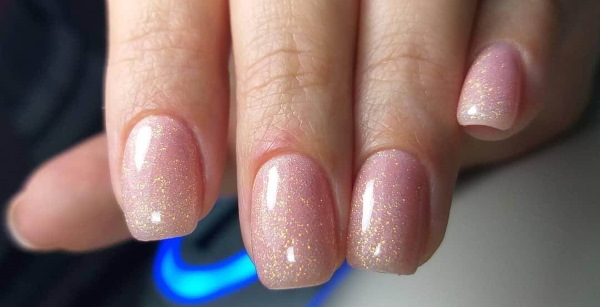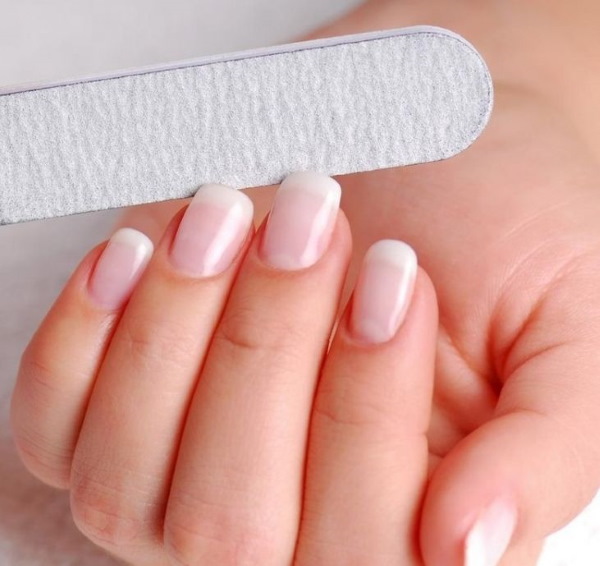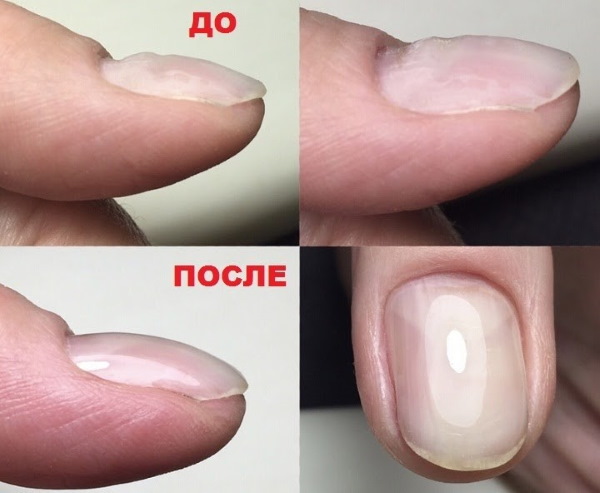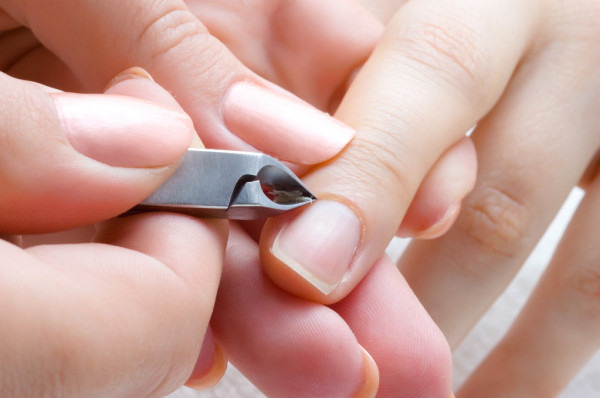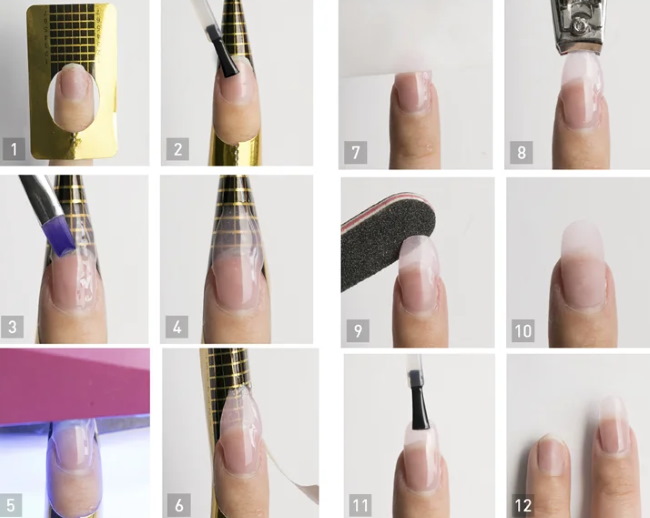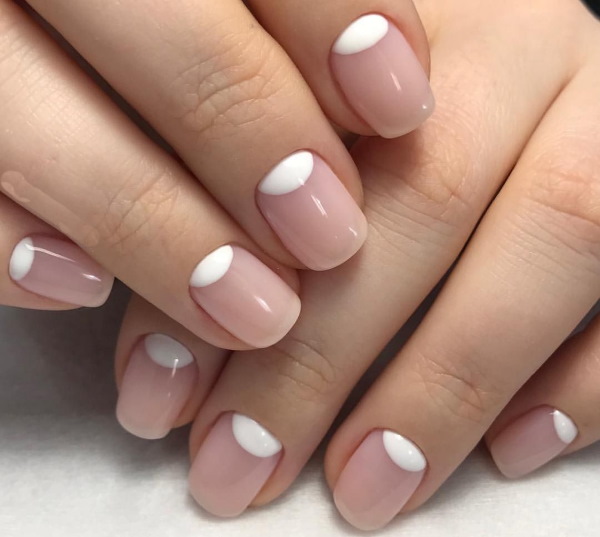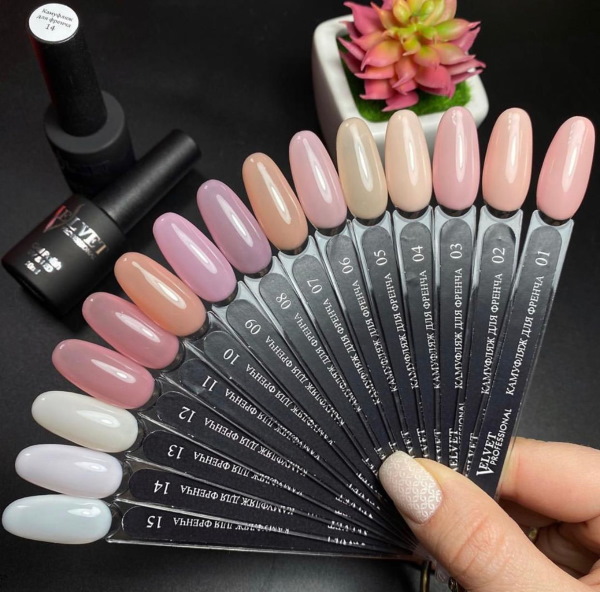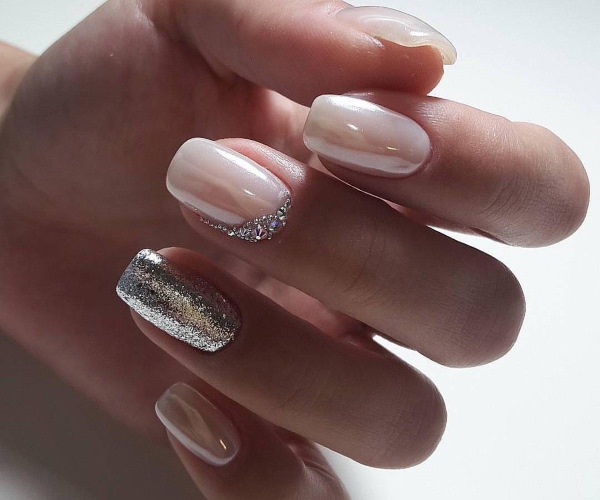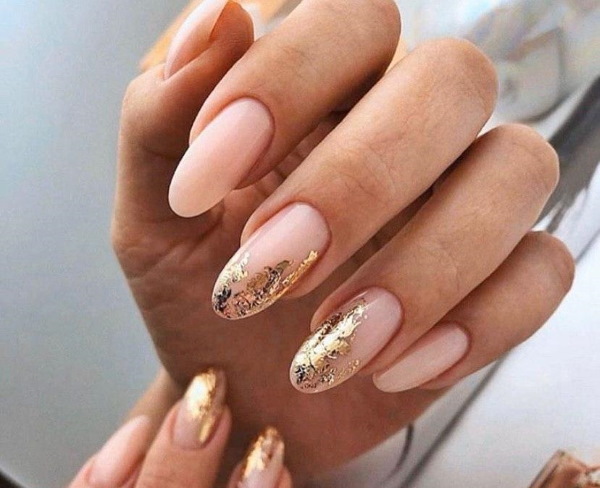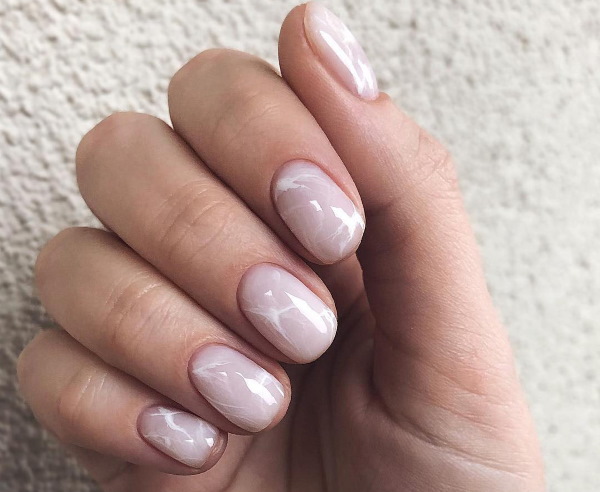A special professionalism in the field of nail service is the ability of the master to give a manicure a natural look. Manufacturers of products for the nail industry have developed special camouflage materialsthat go well with sequins.
General recommendations
In addition to defects in the direction of growth or smoothness, a natural nail plate, under the influence of various factors, can change color and look not aesthetically pleasing. Camouflage materials, unlike transparent ones, allow you to correct or completely change the color of the natural nail plate. They have a palette of natural shades, the choice of which depends not only on the individual preferences of the client, but also on the color of the skin.
A camouflage manicure with glitters with the right shade looks natural. The big plus of this manicure is its versatility. It looks harmonious on both long and short nails. The use of ready-made glitter camouflages can reduce design lead time.
The main advantages of using camouflage materials:
- allow you to correct color defects and unevenness;
- strengthen the natural nail;
- reduce the time to complete the design;
- do not require the use of gel polish for color coating.
A powerful lamp is needed to cure densely pigmented camouflages. It should be borne in mind that the wear of the artificial material largely depends on the manicure and the quality of the preparation of the nail plate. Nail service experts recommend performing manicure without soaking the nail plate (hardware or combined).
Techniques and methods
A glitter camouflage manicure is done in three steps:
- manicure (removal of pterygium, removal of cuticles and keratinized skin);
- preparation of the nail plate;
- laying out the material.
The first stage is performed in hardware technology using a set of cutters of various abrasives and diameters. For combined technology, the use of cutting tools is permissible. The preparation of the nail plate is no less important than a clean manicure. A natural nail, in contrast to artificial material, is more flexible and mobile. For maximum camouflage adhesion, it is necessary to remove the gloss from the nail, making the surface more rough.
Then remove excess moisture and apply adhesion agents. The method of laying out the material depends on its type and consistency. The main types of camouflage formulations and their characteristics are described in the table below.
Types of camouflage materials
The table below shows the types of camouflage materials:
| Characteristic | Type of material | ||
| Base | Gels | Polygeli | |
| Consistency |
|
|
|
| Appointment |
|
|
|
| Application technique | Apply with a brush from a bottle and spread the material over the surface of a natural nail. | The first step is to create a thin substrate on the form.After drying with a brush, spread the main layer of the material, forming the architecture. | When modeling on the lower molds, the application scheme is similar to the gel one. The use of the upper forms involves laying out the material on a plastic tip and its subsequent attachment to the nail plate. |
Finish coating
The final stage of any of the above techniques is the application of a topcoat. This protects the surface from abrasion and gives a glossy highlight. The technique of performing a manicure with camouflage bases is called alignment. The substrate in this case is a natural nail, it is he who determines the length of the future manicure. A big plus is the ease of use of the bases.
It is enough to open the bottle and use a brush to distribute the material in the required amount.
The main disadvantage is the consistency of the material, which does not allow to correct significant defects such as:
- lack of a free edge;
- lack of corners and side walls;
- incorrect architecture (downward growing nails, twisted, lack of a transverse arch).
To correct such cases, a harder material (gel or polygel) and a modeling technique will be required. Materials are different in consistency and method of laying out, but they are used for one purpose - to build a correct and symmetrical architecture of the nail. The gel system is more fluid and viscous, and has the ability to self-level. As a result, the material actually spreads itself over the surface.
The brush only sets the direction of movement, barely touching the camouflage gel with it. For modeling, paper disposable forms on an adhesive basis are used. Polygel is a mixture of gel and acrylic powder and therefore has a thicker consistency. It allows the use of the modeling material on the lower disposable molds and the upper plastic ones.
The peculiarity of using the latter is that I put the material in a plastic tip, and then attach it to a natural nail. The shape gives the correct architecture and surface smoothness. When applying the material, use a brush soaked in a special liquid. It prevents the pile from sticking to the polygel during its distribution in shape.
Master class of classic camouflage with sequins
Manicure camouflage with sequins using the base alignment technique is carried out according to the following sequential scheme:
- Hand sanitizing. Removal of pterygium, keratinized skin, overgrown cuticle in hardware or combined technique, sawdust form.
- Removing the glossy layer of natural nails with a soft file (abrasive 180/240), lifting the upper flakes.
- Application of a dehydrator to remove excess moisture from the surface. After complete drying in the open air, apply a primer. Evaporating, the liquid leaves a sticky layer that serves as double-sided tape.
- Apply a thin layer of base coat with rubbing movements and dry a full cycle in the lamp.
- Before leveling, the nail plate is covered with a layer of camouflage base, this will moisturize the surface and facilitate distribution. A drop of the base is set in the center of the nail and distributed, pushing it to the cuticle, and then brushed off the free edge. The result must be cured in the lamp.
- If the camouflage base does not contain shimmer, it is necessary to apply glitter after mixing it with dry glitter and a transparent base. Otherwise, you can add them to the bottle.
- The result is fixed with a top and dried in a lamp. When using a top with a sticky layer after polymerization, it must be removed using lint-free wipes and a special liquid.
Modeling with camouflage gel on paper forms
Step-by-step scheme for performing modeling with camouflage gel on paper forms:
- By analogy with the previously described technology, it is necessary to disinfect hands, manicure, and prepare the nail plate. After that, rub in a thin layer of the base and dry in a lamp.
- Before installing the paper form, it must be trimmed in the smile zone and side ridges to repeat the anatomical shape of the nail. This will allow the mold to fit snugly against the free edge. The indentations in the area of the side ridges will form the correct transverse arch.
- The form must be glued, set under the free edge, observing the central axis and press the adhesive base to the finger. Particular attention must be paid to the end face. The shape should stand clearly under the nail, without touching the hyponychium. Otherwise, a step is formed.
- A small amount of gel is applied to the mold to form a thin substrate for the future nail. The material is distributed over its surface, connecting the free edge with a natural nail. It is important to work out the points of growth and side walls with high quality. The markings applied to the forms are a hint and guide for the master. The result must be dried for a full cycle.
- After polymerization, the substrate is coated with a layer of gel to moisturize and improve material distribution. A small drop is collected on the brush and placed in the center of the nail bed. Slightly sinking the brush into the material, it is moved to the cuticle, after which the remainder of the gel is brought to the free edge with a superficial touch. The thickness of the material at the end should not exceed the thickness of the credit card. The result must be dried for a full cycle.
- After modeling all ten fingers, the sticky layer is removed from the surface of the gel and the architecture is modified with a file (if necessary), giving clarity to the selected shape.
- The dust remaining as a result of sawdust is brushed off with a stiff brush and carefully wiped off the nails with a lint-free cloth dipped in a degreaser.
- Glitter is applied to the surface using the chosen technique or other design and polymerized in a lamp.
- A topcoat is applied to prolong the wearability of the design, polymerized and tack free if necessary.
To apply camouflage gel, you need to choose a brush that is comfortable in shape and size. Nail service experts do not recommend taking too wide and fluffy brushes. It is more convenient to use a flat, rounded or square brush, the size of which does not exceed ½ the width of the nail plate.
Lunar sequin camouflage
The idea of a lunar camouflage glitter manicure is to focus on the lunula area of a natural nail. Sometimes this design is called a moon jacket.
There are three options for performing this design:
- hole drawing;
- combined;
- covering the nail while maintaining the natural shade of the hole.
In the first case, only the hole in the cuticle area is drawn with sparkles. This option can be combined with a classic jacket. In this design, most of the nail remains free of sparkles. An alternative option is to cover the nail plate with glitter in such a way that the area of the hole remains intact. This option is more suitable for creating an accent on one or two fingernails.
Nail service experts recommend taking gel polishes with a high saturation of sparkles. Otherwise, it is better to prepare the batch yourself from dry glitter and a transparent base. For beginners, there are special stencil stickers. They allow for a symmetrical design with clean lines.
Options in different shades
Most camouflage bases and gels vary in shades from pale pink to beige. Manufacturers are trying to make the material natural and adapt to different types of leather. There is also a milk camouflage base. Despite the fact that her shade has nothing to do with skin color, she is very popular.White is an achromatic color, its uniqueness is that it is versatile and suitable for any skin type.
Milk bases look gentle and harmonious. Close attention should be paid not only to the shade, but also to the density of the material, especially when it comes to bases. Translucent ones can only slightly correct the shade of the natural plate, the denser ones completely block it. The more the material is saturated with pigment, the more powerful lamp will be required for its polymerization.
With stretch marks
Glitter manicure camouflage has many advantages:
- versatility;
- showiness;
- availability;
- ease of execution.
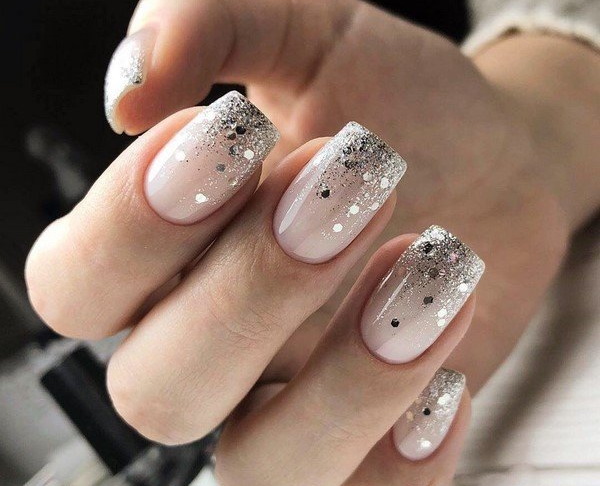
The simplest option is to completely cover the nail plate with sparkles. Typically, this technique covers all ten fingers.
The following materials are most often used for this design:
- base with shimmer;
- base with small sparkles;
- crystal cat;
- gel polish with glitter.
The most popular option is to do the stretch with sequins. The design resembles the gradient technique, where colors are connected with a smooth transition. Depending on individual preference or the general concept of the manicure, glitter is applied in a similar way. The material is placed densely on one part of the nail and gradually reduced to nothing. Manufacturers of decorative elements produce a special series.
It is a set of glitters of different sizes, similar in shade and effect, in one jar. Such combinations add volume and depth to the design, and also eliminate the need to purchase each type separately.
Decor ideas
The glitter camouflage manicure is harmoniously combined with other decorative elements and techniques. This is due to the fact that both materials used in this design are universal.
The list of the most popular decor is represented by the following positions:
- rhinestones;
- foil;
- sliders;
- stickers;
- dried flowers.
The composition of rhinestones gives the manicure an extraordinary shine when the sun's rays hit their surface. Compositions with stones of various sizes, crystal chips and broths look the most harmonious.
Nail service experts recommend placing rhinestones according to the following patterns:
- along the cuticle line;
- by the shape of the hole;
- from the middle of the cuticle to the lateral ridge;
- in the center;
- chaotic;
- geometrically.
Tear-off foil and gold leaf visually create an aging effect on the surface of the nail. They go well with glitter and dried flowers. The foil is attached to the sticky layer left after polymerization and covered with a top. The use of dried flowers is a more laborious process. Miniature dry items are very fragile and require care. Many dried flowers have a slight bulge.
That is why, to create a smooth surface, it is necessary to apply the top with a middle layer with a slight additional leveling. For beginners, using sliders and stickers is a great solution. The technique of their application consists in transferring the pattern from the base to the nail and then fixing it with the top.
In addition to decor, there are a number of design techniques that are no less successfully combined with camouflage materials:
- ombre;
- stamping;
- marble technique;
- foam design;
- watercolor.
The group of express (fast) designs includes all techniques except watercolor. However, it should be borne in mind that these designs can be completed quickly, having mastered the technique and the necessary skills. Otherwise, it will take time to train. Glitter manicure is the most popular but not the only option available with camouflage.
Taking into account the characteristics and properties of materials, the palette of shades and wisely using the range of products for nail art, you can create your own unique designs.
Glitter camouflage manicure video
How to make a glitter camouflage manicure:

